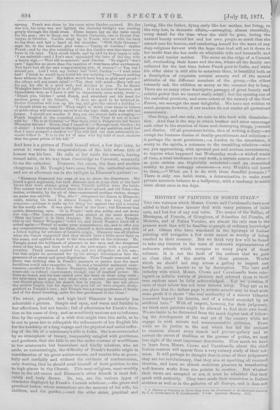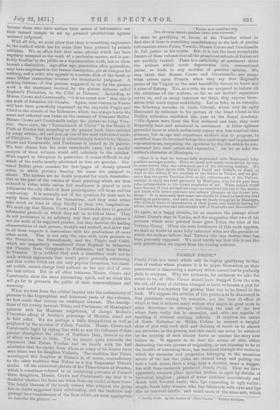HISTORY OF PAINTING IN Noirra ITALY.* THE two volumes which
Messrs. Crowe and Cavalcaselle have now added to their former labours deal with many painters of littlo note, and but few of any real value. The names of the Bellini, of Mantegna, of Francia, of Giorgioue, of Sebastian del Piombo, of Moretto, and of Palma Vecchio, are almost the only ones in the present work that will ho familiar to people of ordinary knowledge of art. Others who have wandered in the byeways of Italian painting will recognize a few more names as worthy of being recalled to their memory. But we think very few will be found to take any interest in the mass of unknown representatives of unknown schools which occupies so many pages of these volumes. It is not the fault of the authors that we gain no clear idea' of the merits of these painters. Works which we should not step across a gallery to inspect can hardly be made known to us by description. The care and industry with which Messrs. Crowe and Cavalcaselle have cata- logued an infinite variety of pictures and referred them to their true authors must be fully acknowledged. Yet we question if some of their labour has not been thrown. away. They toll us in one place that ths dullest page in artistic annals may be read with some profit if it shows "the real mediocrity of a master hitherto honoured beyond his deserts, and of a school encircled by an artificial halo." With all respect, however, for their judgment, we think such painters might be allowed to find their own level. We are liable to be distracted from the much higher task of follow- ing the development of the real art of the country while we engage in such minute and unremunerative criticism. Even while we do justice to the zeal which has led the authors to examine almost every church and picture-gallery and to correct the errors of tradition or the guesses of guides, we may lose sight of the most important discoveries. How much we have to learn from Messrs. Crowe and Cavalcaselle about the chief Italian masters will appear from a very cursory study of their vol- umes. It will perhaps be thought that in some of their judgments they are too revolutionary, that they aim at upsetting all received theories, and have an almost malicious pleasure in transferring well-known works from one painter to another. But whether their views are accepted or not, it must be admitted that they speak with authority. They have made their researches in Italian. archives as well as in the galleries of all Europe, and it does nob
N. A llietory of Painting in North Italy from the Allrteenth to the Sixteenth CinturY•
By J. A. Crowe and. U. B. Cavaloaeolle. I vole. Loudon Murray.
become those who have neither their means of information nor their trained insight to set up personal predilections against matured judgment.
With all this, we must allow that there is something unpleanut in the method which has for some time been pursued by artistic criticism. We so often find that some picture which has been regularly accepted as the work of a particular master, and is per- fectly familiar to the public as a representative work, has no claim to such a distinction. Age after ago, generation after generation, may have acquiesced in the former description, yet all this goes for nothing, and a critic who appeals to a certain flick of the brush or some hidden mannerism reverses the immemorial judgment. A striking instance of this process suggested to us by the present work is the treatment received by the picture hitherto called Raphael's Fornarina, in the Uffizi at Florence. According to Messrs. Crowe and Cavalcaselle, "it is no secret now" that this is the work of Sebastian del Piombo. Again, most visitors to Venice will have been powerfully impressed by the exquisite Virgin and Child in the church of the Redentore, which; has always borne the name and reflected new lustre on the memory of Giovanni Bellini. Messrs. Crowe and Cavaleaselle assign the picture to Luigi Viva- xini. Once more, the "Entombment of Christ" in the Monte di Pieth at Treviso has, according to the present book, been extolled by many writers, old and new, as one of the most undoubted works of Giorgione. Yet that fame is unhesitatingly denied it by Messrs. Crowe and Cavalcaselle, and Pordeuone is named as its painter. We have chosen here the most remarkable cases, but a careful analysis of these volumes would add infinitely to the nuinber. With regard to Giorgione in particular, it seems difficult to say which of the works usually attributed to him are genuine. Gio- vanni Bellini gives occasion for four 'pages of closely printed notes, in which pictures bearing his name are assigned to others. The authors are no doubt prepared for much dissatisfac- tion on the part of the owners of those paintings which are thus reduced in value, while unless full confidence is placed in such judgments the only effect of their promulgation will be an endless controversy. It is naturally out of the question for most men to verify these observations for themselves, and they must either take much on trust or cling blindly to their own imaginations.
We must say that Messrs. Crowe and Cavalcaselle have in general substantial grounds on which they ask us to follow them. They do not pronounce in an arbitrary way that any given picture is not the work of its supposed painter, but they describe the leading characteristics of each picture, its style and method, and show that in all these respects it harmonizes with the productions of some other artist. This is not only the case with such pictures as the Fornarina, the Entombment, and the Virgin and Child, which are respectively transferred from Raphael to Sebastian del Piombo, from Giorgione to Pordenone, and from &end to Vivarini. It is evident that such a transition could not be FAMILY PRIDE.* accuracy, " Facies non omnibus lino, Nee diverse tamen, qualem decet ease serorum."
It must be gratifying to lovers of the Venetian school to find that if there is something unsatisfactory in the lack of precise information about Palma Vecchio, Messrs. Crowe and Cavalcaselle do full justice to his merits. But it is not the least remarkable feature of these volumes that all the prominent schools of Italian art are worthily treated. There is a catholicity of sentiment about the authors which never degenerates into conventional praise, or leads to any sacrifice of genuine opinion. We may think that Messrs. Crowe and Cavalcaselle are some- what severe upon Francia when they say that Raphael's praise of his Virgins as the most beautifully devout he knew was a piece of flattery. Yet, as a rule, we are prepared to indorse all the criticisms of our authors, so far as our limited experience serves us, and in many instances we think they express them- selves with much vigour and felicity. Let us take, as an example, the following remarks on Carlo Crivelli, which may be aptly illustrated by reference to his picture of the Dead Christ hi the Dudley collection exhibited this year at the Royal Academy.
"Ills figures were from the first withered and lean, they were frequently lame and unnatural in movement. A bitter ugliness pervaded faces in which melancholy repose was loss habitual than grimace, but as age and experience enabled him to progress, he modelled these ill-favoured beings into most tragic and impassioned representations, surprising the spectator by the life which he con- ' centrated into their action and expression." Or let us take the author's character of Mautegna
Here it is that we become fully acquainted with Itiantegna's lofty position amongst artists. Here we mark how much more gifted he was in some senses than the celebrated men of the following century. We compare his giant figure with Titian's David and Goliath, or death of Abel in the coiling of the sacristy at the Salute in Venice, and we per- ceive that the great Venetian lives on the achievements of the Paduan, content to enjoy the fruit garnered by Mantogna, who for his part fixes rules indispensable to the future expansion of art. What indeed would have become of that art had not some one sacrificed the end to the means, and dwelt with severe patience and solemn pleasure on the dryeat pro- blems? It is necessary that some one should be found to level the road leading to perfection ; and such an one we justly recognize in Montagne, who without sense of spontaneous or ideal grace, and without feeling for colour, had the power and indomitable will of Donatello and Buonarrotti."
Or again, as a happy surmise, let us mention the passage about
Albert Diirer's stay in Venice, and the suggestion that two of his pictures which were painted there gave Titian the idea of the Tribute-Money. When the next instalment of this work appears, we shall no doubt be more fully informed what are the grounds on which the authors believe that Titian's life was shorter than has been generally supposed. We need hardly say that this is not the only gratification we expect from the coining volumes.































 Previous page
Previous page